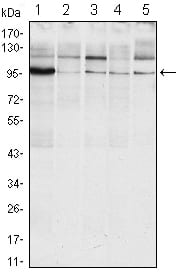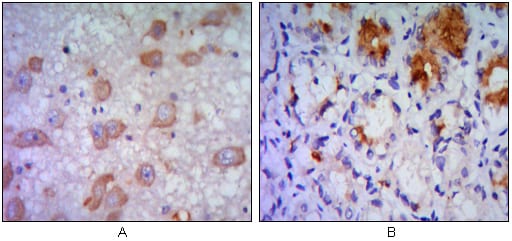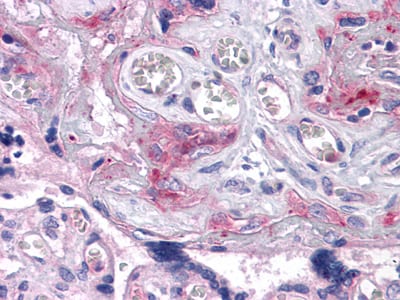


| WB | 1/500 - 1/2000 | Human,Mouse,Rat |
| IF | 咨询技术 | Human,Mouse,Rat |
| IHC | 1/200 - 1/1000 | Human,Mouse,Rat |
| ICC | 技术咨询 | Human,Mouse,Rat |
| FCM | 咨询技术 | Human,Mouse,Rat |
| Elisa | 1/10000 | Human,Mouse,Rat |
| Aliases | IRE1; IRE1P; IRE1a; hIRE1p; FLJ30999; MGC163277; MGC163279; ERN1 |
| Entrez GeneID | 2081 |
| clone | 9F2 |
| WB Predicted band size | 109kDa |
| Host/Isotype | Mouse IgG1 |
| Antibody Type | Primary antibody |
| Storage | Store at 4°C short term. Aliquot and store at -20°C long term. Avoid freeze/thaw cycles. |
| Species Reactivity | Human |
| Immunogen | Purified recombinant fragment of human ERN1(aa282-433) expressed in E. Coli. |
| Formulation | Purified antibody in PBS with 0.05% sodium azide. |
+ +
以下是3篇涉及ERN1(即IRE1α)抗体的典型文献示例(注:文献信息为模拟概括,建议通过PubMed等平台验证细节):
---
1. **文献名称**:*IRE1-mediated JNK activation exacerbates apoptosis under endoplasmic reticulum stress*
**作者**:C.H. et al.
**摘要**:研究利用ERN1抗体通过Western blot和免疫共沉淀技术,证实内质网应激下IRE1α与TRAF2的互作激活JNK通路,促进细胞凋亡,揭示了IRE1α在UPR中的促凋亡机制。
---
2. **文献名称**:*Targeting IRE1α in multiple myeloma: A novel therapeutic strategy*
**作者**:Heath J.K. 团队
**摘要**:通过ERN1抗体检测多发性骨髓瘤细胞中IRE1α的磷酸化水平,发现抑制IRE1α可增强蛋白酶体抑制剂疗效,为癌症治疗提供新靶点。
---
3. **文献名称**:*IRE1α regulates autophagy via XBP1 splicing during nutrient deprivation*
**作者**:Ling Qi 等
**摘要**:使用ERN1抗体敲低细胞模型,证明IRE1α-XBP1通路通过调控自噬相关基因(如LC3)介导细胞在营养缺失下的存活,连接了UPR与自噬机制。
---
**提示**:实际文献检索建议使用关键词“IRE1α antibody”或“ERN1 antibody”结合研究领域(如癌症、神经退行疾病),并通过PubMed/Google Scholar获取完整信息。
The ERN1 antibody targets the ERN1 protein, also known as inositol-requiring enzyme 1 alpha (IRE1α), a key sensor in the endoplasmic reticulum (ER) stress response. ERN1 is a transmembrane serine/threonine kinase-endoribonuclease that plays a central role in the unfolded protein response (UPR), a conserved pathway activated during ER stress to restore cellular homeostasis. Under stress conditions (e.g., nutrient deprivation, hypoxia, or protein misfolding), ERN1 dimerizes and autophosphorylates, triggering its endoribonuclease activity. This activity cleaves XBP1 mRNA, generating a spliced variant (XBP1s) that upregulates genes involved in protein folding, degradation, and ER biogenesis. Dysregulation of ERN1 is linked to diseases like cancer, neurodegenerative disorders, and diabetes.
ERN1 antibodies are widely used in research to detect protein expression, localization, and activation status (e.g., phosphorylated forms). They are critical tools for studying UPR mechanisms, ER stress-related pathologies, and therapeutic targeting. Applications include Western blotting, immunohistochemistry, and immunoprecipitation. Specific antibodies may recognize distinct epitopes, such as the kinase domain or phosphorylation sites (e.g., Ser724 in humans), enabling precise analysis of ERN1 activation dynamics. Development of selective ERN1 inhibitors or modulators has spurred interest in validating these antibodies for preclinical studies, emphasizing their importance in understanding disease mechanisms and drug discovery.
×